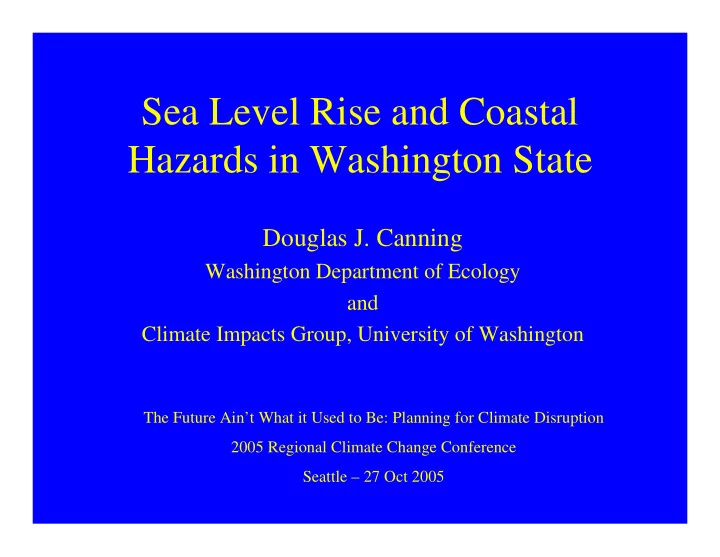

Sea Level Rise and Coastal Hazards in Washington State Douglas J. Canning Washington Department of Ecology and Climate Impacts Group, University of Washington The Future Ain’t What it Used to Be: Planning for Climate Disruption 2005 Regional Climate Change Conference Seattle – 27 Oct 2005
Climate & Cascadia Coastal Zone •Sea Level Rise • Coastal erosion • Inundation • Other... • Combined with increased winter precipitation • Bluff landsliding • Flooding
Vertical Land Movement... Vertical Land Movement... • … alters sea level rise rates • Subduction zone tectonic forces ‘wrinkle’ the land surface: • Uplift occurs on most of the Ocean coast • Subsidence occurs in most of Puget Sound
Friday Harbor sea level trend From 1935 to the present, water level at the Friday Harbor gage has been rising at about the global average.
Seattle sea level trend From 1900 to the present, water level at the Seattle gage has been rising at about 2X the global average.
Neah Bay sea level trend From 1935 to the present, water level at the Neah Bay gage has been trending down.
Barometric Pressure Effects Short term low pressure cells allow water level to rise: up to 2.0 ft on 22 Nov 2001 at Tacoma
Regional Changes in Sea Level 70 Eastern Pacific 60 Equatorial 50 Atlantic ) m c ( 40 NW e s i Atlantic R l e v e 30 L a e S 20 10 Arctic Ocean 0 1991 2001 2011 2021 2031 2041 2051 2061 2071 2081 2091 Source: Canadian Climate Change Model
Combining it all for Washington...
Sea Level Rise & Inundation Port of Olympia Peninsula
Coastal Erosion Point Brown, Ocean Shores — 1997 - 98
Puget Sound Bluff Landsliding
Management & Response • Shoreline Management Act • Local Shoreline Master Programs • Growth Management Act • Local Geologic Hazards Critical Area • Floodplain Management Act • Local Comprehensive FCM Plans • Puget Sound Plan • Aquatic Lands Management Act
SLR Response as Risk Response • We respond to flood hazards by linking what’s at risk with the probability of flood risk, e.g. higher risk situations are managed by applying progressively lower probability, higher severity events (e.g. 100 year, 500 year event). • We could respond to SLR hazards by associating what’s at risk with the severity of the SLR scenario, e.g. higher risk situations are managed by applying progressively more aggressive SLR scenarios.
Douglas J. Canning Shorelands Program, Washington Department of Ecology dcan461@ecy.wa.gov Climate Impacts Group, University of Washington
Recommend
More recommend